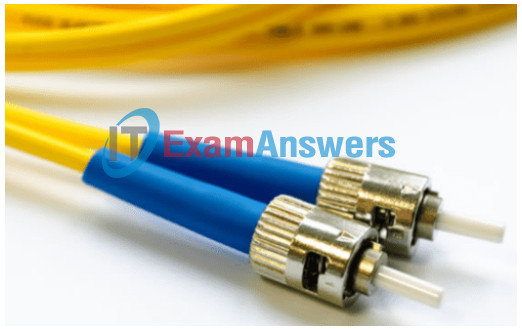6.2.3 Network Media Quiz Answers. Networking Basics Module 6 quiz exam answers
1. A network technician is extending the network from the main office building over several hundred meters to a new security station. The security station needs a high speed connection to support video surveillance of the main building. What type of cable is best suited to connect the security station to the rest of the main office network?
- coax
- fiber optic
- shielded twisted pair
- unshielded twisted pair
Explanation: Fiber optic cable can deliver signals over distances of several miles. Because it uses light, fiber is impervious to RFI and EMI and is superior to signals sent over copper or aluminum wiring.
2. What are two common media used in networks? (Choose two.)
- copper
- water
- nylon
- fiber
- wood
Explanation: Common media used in networks include copper, glass or plastic optical fiber, and wireless.
3. Which type of network cable is commonly used to connect office computers to the local network?
- coaxial cable
- twisted-pair cable
- glass fiber-optic cable
- plastic fiber-optic cable
Explanation: Twisted-pair is a type of copper cable used to interconnect devices on a local network.
4. Which three factors should be considered when choosing the appropriate network media? (Choose three.)
- the speed of the CPU and amount of memory in servers
- the environment in which the media is installed
- the data security and fault tolerance requirement
- the amount of data and the data transfer rate desired
- the distance between hosts that the media will connect
- the operating systems used on network devices in the network
Explanation:
Several criteria should be considered when selecting network media:
- The cost of the media and installation
- The environment in which the media is installed
- The amount of data and the data transfer rate desired
- The distance between hosts that the media will connect
5. Refer to the graphic. What type of cabling is shown?

6.2.3 Network Media Quiz Answers
Explanation:
Network cabling include different types of cables:
- UTP cable consists of four pairs of color-coded wires that have been twisted together and then encased in a flexible plastic sheath.
- STP cable uses four pairs of wires, each wrapped in a foil shield, which are then wrapped in an overall metallic braid or foil.
- Coaxial cable uses a copper conductor and a layer of flexible plastic insulation surrounds the copper conductor.
- Fiber cable is a flexible, extremely thin, transparent strand of glass surrounded by plastic insulation.
6. What makes fiber preferable to copper cabling for interconnecting buildings? (Choose three.)
- greater distances per cable run
- lower installation cost
- limited susceptibility to EMI/RFI
- durable connections
- greater bandwidth potential
- easily terminated
Explanation: Optical fiber cable transmits data over longer distances and at higher bandwidths than any other networking media. Unlike copper wires, fiber-optic cable can transmit signals with less attenuation and is completely immune to EMI and RFI.
7. Which type of network media carries data encoded into electrical impulses?
- copper cable
- wireless media
- fiber-optic cable
- cellular communication media
Explanation:
Data is transmitted across a network on media. Modern networks primarily use three types of media to interconnect devices:
- Metal wires within cables (copper cable) – Data is encoded into electrical impulses.
- Glass or plastic fibers within cables (fiber-optic cable) – Data is encoded into pulses of light.
- Wireless transmission – Data is encoded via modulation of specific frequencies of electromagnetic waves.
8. Which two types of network media carries data encoded into electrical impulses? (Choose two.)
- coaxial cable
- wireless media
- twisted-pair cable
- glass fiber-optic cable
- plastic fiber-optic cable
Explanation:
Data is transmitted across a network on media. Modern networks primarily use three types of media to interconnect devices:
- Metal wires within cables (copper cable) – Data is encoded into electrical impulses. Twisted-pair Ethernet cable and coaxial cable are two types of copper cable.
- Glass or plastic fibers within cables (fiber-optic cable) – Data is encoded into pulses of light.
- Wireless transmission – Data is encoded via modulation of specific frequencies of electromagnetic waves.
9. Which type of network media carries data encoded into impulses of light?
- coaxial cable
- wireless media
- fiber-optic cable
- twisted-pair cable
Explanation:
Data is transmitted across a network on media. Modern networks primarily use three types of media to interconnect devices:
- Metal wires within cables (copper cable) – Data is encoded into electrical impulses. Twisted Ethernet cable and coaxial cable are two types of copper cable.
- Glass or plastic fibers within cables (fiber-optic cable) – Data is encoded into pulses of light.
- Wireless transmission – Data is encoded via modulation of specific frequencies of electromagnetic waves.
10. A network administrator in a small office is upgrading the local network within the building. New network cables are needed to connect office computers and networking devices. Which network media should the administrator use?
- coaxial cable
- wireless solution
- fiber-optic cable
- twisted-pair cable
Explanation: Twisted-pair Ethernet cables are most often used to physically connect local devices in a small office to the local network within a building.
11. What is the purpose of using twisted pairs of wires in an Ethernet cable?
- to reduce interference
- to provide higher bandwidth
- to identify paths of data flow
- to ensure that the transmission of electrical signals is extended over a longer distance
Explanation: Ethernet technology generally uses twisted-pair cables to interconnect devices. In a twisted-pair cable, wires are grouped in pairs and twisted together to reduce interference.

